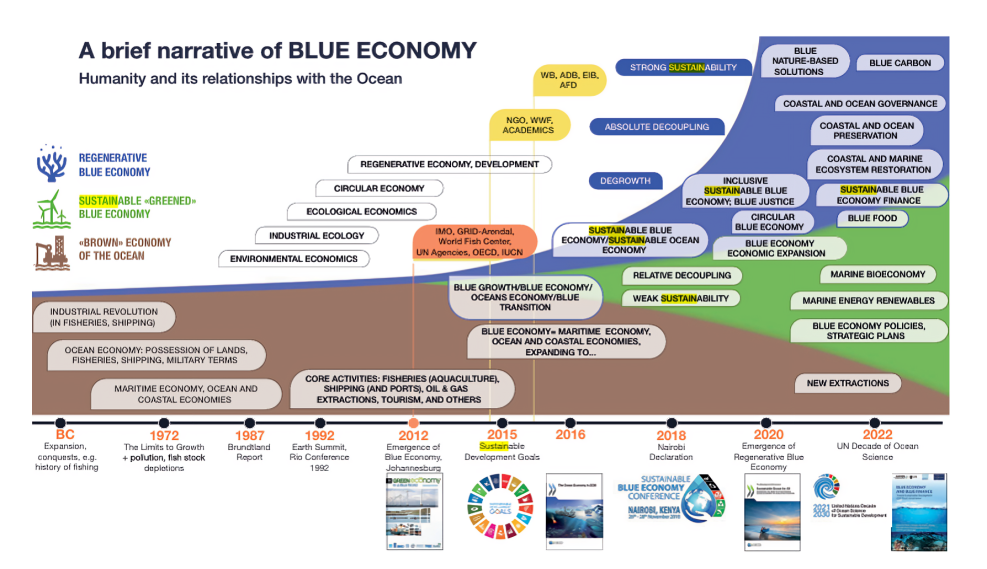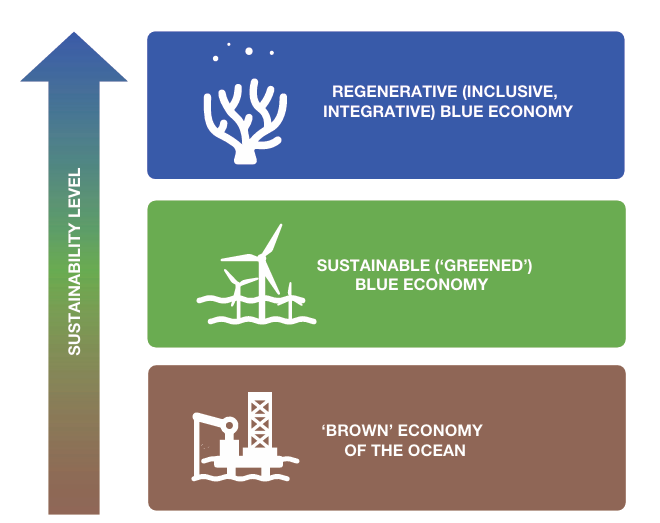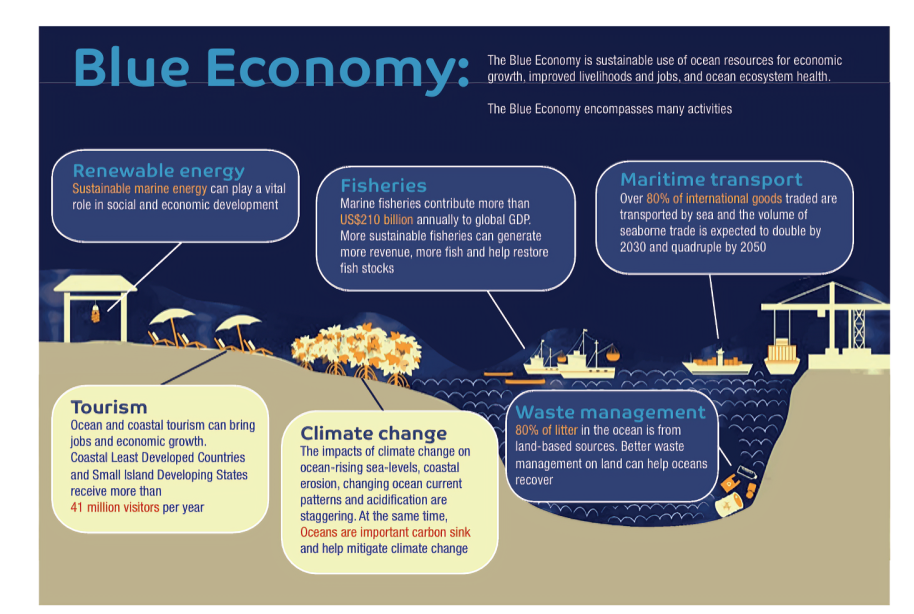Biodiversity & Environment
Regenerative Blue Economy
- 02 May 2024
- 9 min read
For Prelims: International Union for Conservation of Nature, Regenerative Blue Economy, Blue Economy, Circular economy, Blue Carbon, Great Blue Wall Initiative, Maritime India Vision 2030
For Mains: Significance of the Blue Economy, Challenges Related to Regenerative Blue Economy, Steps taken by the Government to Promote the Blue Economy.
Why in News?
The International Union for Conservation of Nature (IUCN) has released a report outlining a roadmap for a Regenerative Blue Economy (RBE).
- This approach goes beyond mere sustainability, aiming to actively restore and revitalize our oceans.
What are the Key Highlights of the Report?
- Proposes a Hierarchy: The report proposes a hierarchical structure to categorize different interpretations and levels of sustainability within the Blue Economy concept, they are:
- Ocean/Brown Economy: Refers to all economic activities directly or indirectly related to the ocean.
- Synonymous with the traditional "marine economy" or "maritime sectors".
- Includes sectors like shipping, ports, fisheries, offshore oil/gas, etc.
- Follows a business-as-usual approach focused on economic contribution.
- Sustainable Blue Economy: Incorporates principles of environmental sustainability and ecosystem protection. Extends scope beyond just economic activities to include:
- Conservation and restoration of marine/coastal ecosystems.
- Valuation of ecosystem services like carbon sequestration.
- It includes major ocean industries, but with sustainability qualifications.
- Aligns with UN Sustainable Development Goals, especially SDG 14 on oceans about conserving and sustainably using the oceans, seas and marine resources.
- Regenerative Blue Economy: RBE goes beyond simply maintaining ocean health. It aims to actively restore and revitalize marine ecosystems.
- It is an economic model that combines rigorous and effective regeneration and protection of the Ocean and marine and coastal ecosystems with sustainable, low, or no carbon economic activities, and fair prosperity for people and the planet, now and in the future.
- Founding Principles of RBE:
- Protection and Restoration: Regenerate and protect marine and coastal ecosystems, resources, and natural capital. Combat climate change and biodiversity loss.
- Inclusive Economic System: Ensure inclusion, fairness, and solidarity within the economic system. Guarantee well-being, resilience, and reduced vulnerability to climate change, supported by sustainable funding.
- Inclusive and Participatory Governance: Establish an inclusive and participatory governance system with transparency. Integrate flexible legal and regulatory mechanisms into international agreements on climate and biodiversity.
- Low or No Carbon Activities: Prioritize low or no carbon activities that positively impact the regeneration of marine and coastal ecosystems and enhance the well-being of local populations.
- Priority Implementation in Island States: Implement RBE as a priority in island states with specific requirements. Consider the needs of coastal populations, particularly Indigenous peoples, and recognise their traditions in the implementation process.
- Ocean/Brown Economy: Refers to all economic activities directly or indirectly related to the ocean.
- Spectrum of Sustainability:
- The IUCN acknowledges various sustainability levels within the blue economy concept.
- RBE represents the most ambitious and restorative approach, moving beyond "business as usual" and "sustainable use" to actively restore ocean health.
- Principles of Blue Economy:
- The report states that various sets of principles proposed by different organizations (World Wildlife Fund, United Nations Global Compact, etc.)
- Common themes include: ecosystem health, sustainability, inclusivity, good governance.
- Blue Carbon and Nature-based Solutions:
- The report emphasizes the importance of valuing coastal/marine ecosystem services like carbon sequestration.
- Blue Carbon is highlighted as an emerging market opportunity and component of sustainable economies.
- Blue Carbon aligns with the broader push for Nature-based Solutions for climate change/biodiversity.
- Key Sectors and Considerations:
- Fishing and aquaculture must adopt sustainable methods, avoid overfishing and habitat destruction
- Preference for small-scale fisheries, eco-friendly aquaculture like shellfish/algae
- Maritime transport needs transition to low/zero-carbon fuels and technologies
- Establishment of Marine Protected Areas (MPAs) to compensate for extractive activities.
- Fishing and aquaculture must adopt sustainable methods, avoid overfishing and habitat destruction
- Connections to Other Approaches:
- The report strongly emphasizes the need to combine the Blue Economy principles with those of the circular economy, Bioeconomy , and Social and Solidarity Economy (SSE).
- The bioeconomy is a model for the economy and industry that uses biological resources to produce goods, services, and energy. It's a sustainable and circular model that uses biological resources, processes, and methods across all economic sectors.
- SSE refers to economic activities and relationships that prioritise social and environmental objectives over profit.
- The report strongly emphasizes the need to combine the Blue Economy principles with those of the circular economy, Bioeconomy , and Social and Solidarity Economy (SSE).
What is Blue Carbon?
- Definition: Blue Carbon refers to carbon stored in coastal and marine ecosystems.
- Significance: Coastal ecosystems like mangroves, tidal marshes, and seagrass meadows are crucial carbon sinks, storing more carbon per unit area than terrestrial forests.
- They play a significant role in mitigating climate change and contribute to countries' emissions reduction targets under the Paris Agreement.
- IUCN Involvement: IUCN engages in Blue Carbon initiatives through the Blue Natural Capital Financing Facility (BNCFF) and the Blue Carbon Accelerator Fund (BCAF).
- These initiatives support the development of sound investment-based projects with clear ecosystem service benefits, paving the way for private sector funding.
- Example: The study case of extensive shrimp farming and mangrove protection in Indonesia showcases the potential revenue generated through Blue Carbon initiatives.
What are the Initiatives Promoting Regenerative Blue Economy?
- Global Initiatives:
- IUCN Nature 2030: It is a comprehensive plan for conservation efforts aligning with the United Nations 2030 Agenda for Sustainable Development and the post-2020 global biodiversity framework
- Great Blue Wall Initiative: This African-led initiative aims to help countries reach the following targets:
- protect 30% of the ocean by 2030; achieve net gain of critical blue ecosystems such as mangroves, corals, seagrasses by 2030; develop a regenerative blue economy and create millions of jobs by supporting local communities through funding, training and technical assistance.
- Clean Seas Campaign: Led by the UN Environment Programme (UNEP), this campaign tackles plastic pollution in the ocean by encouraging governments and businesses to reduce single-use plastics.
- Moroni Declaration and Cape Town Manifesto: These recent declarations from African nations highlight the importance of a RBE for the continent's development and call for international support.
- India:
|
Drishti Mains Question: Q. Discuss the principles of Regenerative Blue Economy and its role in marine conservation. Differentiate RBE from conventional Blue Economy models. Assess its socio-economic benefits. |
UPSC Civil Services Examination, Previous Year’s Question (PYQs)
Prelims:
Q. What is blue carbon?
(a) Carbon captured by oceans and coastal ecosystems
(b) Carbon sequestered in forest biomass and agricultural soils
(c) Carbon contained in petroleum and natural gas
(d) Carbon present in atmosphere
Ans: (a)
Q. ‘Invasive Species Specialist Group’ (that develops Global Invasive Species Database) belongs to which one of the following organizations?(2023)
(a) The International Union for Conservation of Nature
(b) The United Nations Environment Programme
(c) The United Nations World Commission for Environment and Development
(d) The World Wide Fund for Nature
Ans: (a)
Mains:
Q. Defining blue revolution, explain the problems and strategies for pisciculture development in India. (2018)








